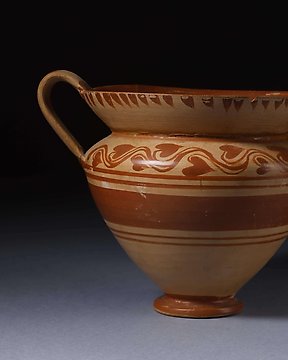
Altgriechisch Daunische Kantharos - 17 cm
Nr. 83804207

Nr. 83804207

Semi-spherical bowl
CULTURE: Ancient Greek
PERIOD: 6th Century BC
MATERIAL: Silver
DIMENSIONS: Diameter 14 cm; height 9 cm.
PROVENANCE: Private collection, London, acquired before 1980.
CONDITION: Intact.
DESCRIPTION:
An ovoid shaped bowl, decorated in the upper third of its body and with a wide, flared mouth. The base is off-centre from the axis of symmetry of the recipient, and for this reason it does not sit in a stable position. It is simply handmade, with the blows from the hammering showing on various areas of the body. The decoration consists of three straight lines around the neck of the bowl with a slight indentation between each one.
Given this shape, we are dealing with a bowl for ritual libation, one which reminds us of a phiale, one of the most characteristic recipients in the Greek period. It was most probably for funerary purposes. The history of this recipient form is very lengthy: it was very much favoured in the eastern and central Mediterranean area, to the point where it became the Greek vessel form par excellence for the religious act of libation as early as the Archaic Period around the 7th Century BC.
The variations in shape on the original are multiple. In many cases it is difficult to determine the date and provenance of pieces that, except in exceptional cases, have no known archaeological context.
BIBLIOGRAPHY:
- CABRERA, Paloma (ed.). La colección Várez Fisa en el Museo Arqueológico Nacional. Ministerio de Educación, Cultura y Deporte. 2003. (p. 447).
Notes:
The seller guarantees that he acquired this piece according to all national and international laws related to the ownership of cultural property. Provenance statement seen by Catawiki.
- The piece includes authenticity certificate.
- The piece includes Spanish Export License (Passport for European Union).
- According to Spanish legislation, items sent outside the European Union are subject to export taxes and will be added to the invoice, at the buyer's expense. These export fees are fixed on the final auction price and the tax rate is not applied directly on the total value of the item to be exported, but rather the different percentages by sections are applied to it:
- Up to 6,000 euros: 5%.
- From 6.001 to 60.000 euros: 10%.
- From 60.001 to 600.000 euros: 20%.
This export permit application process can take between 1-2 months maximum.
- The seller guarantees that he acquired this piece according to all national and international laws related to the ownership of cultural property. Provenance statement seen by Catawiki.
THE MINISTRY OF CULTURE FROM SPAIN ASKS ALL SELLERS FOR INVOICES OR OTHER DOCUMENTATION ABLE TO PROVE THE LEGALITY OF EACH ITEM BEFORE PROVIDING AN IMPORT OR EXPORT LICENSE.
#Connoiseurgallery
So kaufen Sie auf Catawiki
1. Etwas Besonderes entdecken
2. Höchstgebot abgeben
3. Sichere Zahlung durchführen